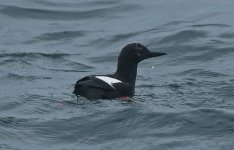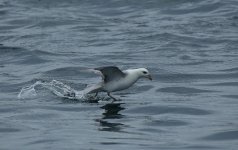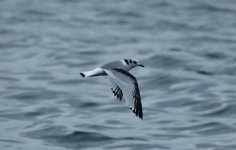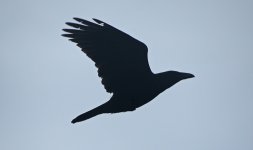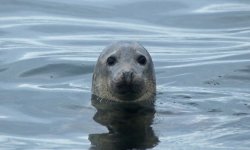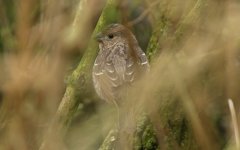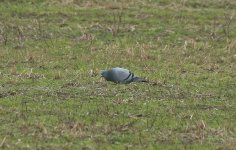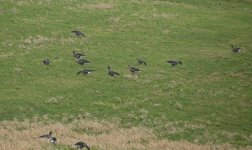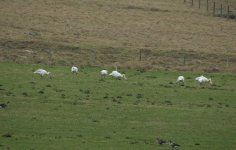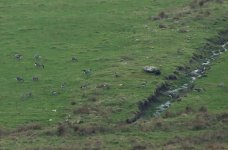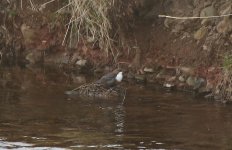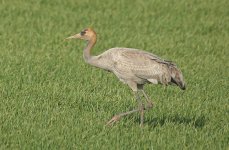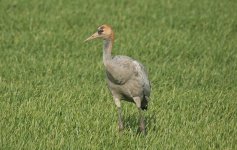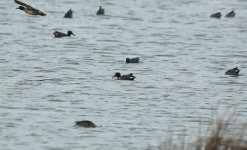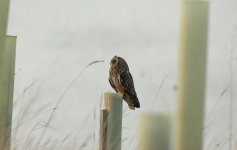-
Welcome to BirdForum, the internet's largest birding community with thousands of members from all over the world. The forums are dedicated to wild birds, birding, binoculars and equipment and all that goes with it.
Please register for an account to take part in the discussions in the forum, post your pictures in the gallery and more.
You are using an out of date browser. It may not display this or other websites correctly.
You should upgrade or use an alternative browser.
You should upgrade or use an alternative browser.
Israel - 14th to 20th February 2019 - with extension 21st to 23rd February 2019 (1 Viewer)
- Thread starter Paul Chapman
- Start date
More options
Who Replied?Paul Chapman
Well-known member
A stop at Cunningsburgh around 12.30pm as we headed south produced the wintering Common Rosefinch visiting feeders. We then headed on to Loch of Spiggie from 1.15pm. This produced perhaps the best Rock Doves of the extension but the target was a distant Pied-billed Grebe seen at 2.30pm on the Loch with a Red-throated Diver and ten Goldeneye. At the south end at 3.15pm, a group of Whooper Swans and twenty one White-fronted Geese shared the fields with the Greylags. The last action of the Shetland extension was spent turfing out a Pink-footed Goose and two Tundra Bean Geese at Sandwick amongst hundreds of Greylag Geese at 4.00pm in the late afternoon. We had recorded 50 species during the day - https://ebird.org/checklist/S53079982
We had an early flight so headed to the Sumburgh Hotel for a night’s sleep – cue more reminiscences – a dinner and more celebratory drinks……..
89. Common Rosefinch
90. Rock Dove
91. White-fronted Geese
92. Whooper Swans
93. Pink-footed Goose & two Tundra Bean Geese with Greylag Geese
We had an early flight so headed to the Sumburgh Hotel for a night’s sleep – cue more reminiscences – a dinner and more celebratory drinks……..
89. Common Rosefinch
90. Rock Dove
91. White-fronted Geese
92. Whooper Swans
93. Pink-footed Goose & two Tundra Bean Geese with Greylag Geese
Attachments
Paul Chapman
Well-known member
Early on Saturday 23rd February, we returned the hire car and connected with our flight back to Edinburgh. It seemed a shame to waste the day so plotted a few targets.
A roadside stop at Cleekhimin Bridge on the A697 at 11.35am produced an expected Dipper and we arrived at our first target destination of Wark at 12.25pm. The first-winter Common Crane was found relatively easily in the company of the Mute Swans. We then headed on towards Druridge but stopped en route at Widdrington Moor Lake at 2.20pm. About 2,000 Pink-footed Geese were an awesome sight with 10 Whoopers and 10 Red-breasted Merganser also present. An adult female Peregrone watched on from a nearby tree. We recorded 29 species in total - https://ebird.org/checklist/S53089416
We finally arrived at Druridge Pools at 2.55pm and after an immature male Peregrine had shuffled things around, eventually, we dug out the male Green-winged Teal from amongst 200 Eurasian Teal at 4.00pm. In total, we recorded 25 species - https://ebird.org/checklist/S53089907
As we headed back past Widdrington Moor Lake at 4.25pm, my last highlight of the trip was a roadside Short-eared Owl. A steady journey back meant I was back home about 72 hours later than originally intended and with a slightly different total species mix than anticipated.
94. Dipper
95 & 96. Crane
97.Green-winged Teal
98. Short-eared Owl
A roadside stop at Cleekhimin Bridge on the A697 at 11.35am produced an expected Dipper and we arrived at our first target destination of Wark at 12.25pm. The first-winter Common Crane was found relatively easily in the company of the Mute Swans. We then headed on towards Druridge but stopped en route at Widdrington Moor Lake at 2.20pm. About 2,000 Pink-footed Geese were an awesome sight with 10 Whoopers and 10 Red-breasted Merganser also present. An adult female Peregrone watched on from a nearby tree. We recorded 29 species in total - https://ebird.org/checklist/S53089416
We finally arrived at Druridge Pools at 2.55pm and after an immature male Peregrine had shuffled things around, eventually, we dug out the male Green-winged Teal from amongst 200 Eurasian Teal at 4.00pm. In total, we recorded 25 species - https://ebird.org/checklist/S53089907
As we headed back past Widdrington Moor Lake at 4.25pm, my last highlight of the trip was a roadside Short-eared Owl. A steady journey back meant I was back home about 72 hours later than originally intended and with a slightly different total species mix than anticipated.
94. Dipper
95 & 96. Crane
97.Green-winged Teal
98. Short-eared Owl
Attachments
Paul Chapman
Well-known member
I recorded 79 species on the Shetland and Northumberland extension:-
1 Greylag Goose – several hundred on south Mainland Shetland on both 21st and 22nd February and 25 at Cleekhimin Bridge, Northumberland on 23rd February
2 Greater White-fronted Goose – 21 at the south end of Lough Spiggie on 22nd February
3 Tundra Bean-Goose – two birds with a Pink-footed Goose and Greylags at Sandwick on 22nd February
4 Pink-footed Goose – a single with two Tundra Bean-Goose and Greylags at Sandwick on 22nd February and about 2,000 at Widdrington Moor Lake on 23rd February
5 Canada Goose
6 Mute Swan
7 Whooper Swan – 13 around the south end of Mainland Shetland on 22nd February and a total of 19 at Widdrington Moor Lake on 23rd February
8 Shelduck
9 Gadwall
10 Wigeon
11 Mallard
12 Eurasian Teal
13 Green-winged Teal – a male at Druridge Pools, Northumberland on 23rd February
14 Tufted Duck
15 Eider
16 Goldeneye
17 Red-breasted Merganser - 10 at Widdrington Moor Lake on 23rd February
18 Pheasant
19 Red Grouse – heard near Bixter on 21st February
20 Pied-billed Grebe – single adult at the south end of Lough of Spiggie on 22nd February
21 Slavonian Grebe – single in Tresta Voe on 22nd Fenruary
22 Great Crested Grebe
23 Rock Dove – some apparently pure birds seen on south Mainland Shetland on 21st and 22nd February
24 Woodpigeon
25 Collared Dove
26 Moorhen
27 Coot
28 Common Crane – single first-winter at Wark on 23rd February
29 Oystercatcher
30 Golden Plover
31 Lapwing
32 Curlew
33 Turnstone
34 Dunlin
35 Redshank
36 Black Guillemot – at least five in Lerwick Harbour on 22nd February
37 Kittiwake – at least five in Lerwick Harbour on 22nd February
38 Black-headed Gull
39 Common Gull – at least 100 around south Mainland Shetland on 22nd February
40 Herring Gull
41 Iceland Gull – at least three at Shetland Catch on 22nd February with a near adult and two immatures
42 Glaucous Gull – small adult at Shetland Catch on 22nd February
43 Great Black-backed Gull
44 Red-throated Diver – single on Lough of Spiggie on 22nd February
45 Fulmar – at least forty seen around south Mainland Shetland on both 21st and 22nd February
46 Gannet – three seen around south Mainland Shetland on 22nd February
47 Cormorant
48 Shag – three seen around south Mainland Shetland on 22nd February
49 Grey Heron
50 Tengmalm’s Owl – near Bixter at roost and then hunting at dusk on 21st February
51 Short-eared Owl – single at Widdrington Moor Lake on 23rd February
52 Buzzard
53 Kestrel
54 Peregrine – female at Widdrington Moor Lake & immature male at Druridge Pools on 23rd February
55 Magpie
56 Jackdaw
57 Rook
58 Carrion Crow
59 Hooded Crow – small numbers seen both days on south Mainland Shetland on 21st and 22nd February
60 Raven – small numbers seen both days on south Mainland Shetland on 21st and 22nd February
61 Skylark
62 Coal Tit
63 Blue Tit
64 Wren
65 Dipper – single at Cleekhimin Bridge on 23rd February
66 Robin
67 European Stonechat
68 Redwing
69 Blackbird
70 Fieldfare
71 Starling
72 Dunnock
73 Meadow Pipit
74 Rock Pipit
75 Chaffinch
76 Greenfinch
77 Common Rosefinch – single at Cunningsburgh on 22nd February
78 Yellowhammer
79 House Sparrow
1 Greylag Goose – several hundred on south Mainland Shetland on both 21st and 22nd February and 25 at Cleekhimin Bridge, Northumberland on 23rd February
2 Greater White-fronted Goose – 21 at the south end of Lough Spiggie on 22nd February
3 Tundra Bean-Goose – two birds with a Pink-footed Goose and Greylags at Sandwick on 22nd February
4 Pink-footed Goose – a single with two Tundra Bean-Goose and Greylags at Sandwick on 22nd February and about 2,000 at Widdrington Moor Lake on 23rd February
5 Canada Goose
6 Mute Swan
7 Whooper Swan – 13 around the south end of Mainland Shetland on 22nd February and a total of 19 at Widdrington Moor Lake on 23rd February
8 Shelduck
9 Gadwall
10 Wigeon
11 Mallard
12 Eurasian Teal
13 Green-winged Teal – a male at Druridge Pools, Northumberland on 23rd February
14 Tufted Duck
15 Eider
16 Goldeneye
17 Red-breasted Merganser - 10 at Widdrington Moor Lake on 23rd February
18 Pheasant
19 Red Grouse – heard near Bixter on 21st February
20 Pied-billed Grebe – single adult at the south end of Lough of Spiggie on 22nd February
21 Slavonian Grebe – single in Tresta Voe on 22nd Fenruary
22 Great Crested Grebe
23 Rock Dove – some apparently pure birds seen on south Mainland Shetland on 21st and 22nd February
24 Woodpigeon
25 Collared Dove
26 Moorhen
27 Coot
28 Common Crane – single first-winter at Wark on 23rd February
29 Oystercatcher
30 Golden Plover
31 Lapwing
32 Curlew
33 Turnstone
34 Dunlin
35 Redshank
36 Black Guillemot – at least five in Lerwick Harbour on 22nd February
37 Kittiwake – at least five in Lerwick Harbour on 22nd February
38 Black-headed Gull
39 Common Gull – at least 100 around south Mainland Shetland on 22nd February
40 Herring Gull
41 Iceland Gull – at least three at Shetland Catch on 22nd February with a near adult and two immatures
42 Glaucous Gull – small adult at Shetland Catch on 22nd February
43 Great Black-backed Gull
44 Red-throated Diver – single on Lough of Spiggie on 22nd February
45 Fulmar – at least forty seen around south Mainland Shetland on both 21st and 22nd February
46 Gannet – three seen around south Mainland Shetland on 22nd February
47 Cormorant
48 Shag – three seen around south Mainland Shetland on 22nd February
49 Grey Heron
50 Tengmalm’s Owl – near Bixter at roost and then hunting at dusk on 21st February
51 Short-eared Owl – single at Widdrington Moor Lake on 23rd February
52 Buzzard
53 Kestrel
54 Peregrine – female at Widdrington Moor Lake & immature male at Druridge Pools on 23rd February
55 Magpie
56 Jackdaw
57 Rook
58 Carrion Crow
59 Hooded Crow – small numbers seen both days on south Mainland Shetland on 21st and 22nd February
60 Raven – small numbers seen both days on south Mainland Shetland on 21st and 22nd February
61 Skylark
62 Coal Tit
63 Blue Tit
64 Wren
65 Dipper – single at Cleekhimin Bridge on 23rd February
66 Robin
67 European Stonechat
68 Redwing
69 Blackbird
70 Fieldfare
71 Starling
72 Dunnock
73 Meadow Pipit
74 Rock Pipit
75 Chaffinch
76 Greenfinch
77 Common Rosefinch – single at Cunningsburgh on 22nd February
78 Yellowhammer
79 House Sparrow
dwatsonbirder
Well-known member
Blimey Paul, that's some going! Interesting report(s) and Israel on my radar with some cracking species observed there, must've been quite a contrast within the 24hr period between leaving Tel Aviv and arriving on Shetland. Also interesting to read about the logistics and madness of twitching - a whole other side of birding to experience.
Glad you caught up with most of your targets.
Glad you caught up with most of your targets.
Richard Prior
Halfway up an Alp

Great read Paul and congratulations on the owl!
wolfbirder
Well-known member
Great stuff, and a very enjoyable read as usual Paul.
Tempted to go back to Israel for Hume's Owl, Oriental Honey Buzzard, Grey Swamphen, Thick-billed lark, which I definitely need, and better views of Pharoah Eagle Owl.
All pretty difficult though, perhaps the swamphen excepted.
Congratulations on the Tengmalm's Owl!
Tempted to go back to Israel for Hume's Owl, Oriental Honey Buzzard, Grey Swamphen, Thick-billed lark, which I definitely need, and better views of Pharoah Eagle Owl.
All pretty difficult though, perhaps the swamphen excepted.
Congratulations on the Tengmalm's Owl!
Last edited:
opisska
rabid twitcher

I would like to just note that Hume's Owl is not a good name for what occurs in Israel and Desert Owl (or, if you really insist, Desert Tawny Owl) is much better. There was a fair amount of confusion in this, but what was originally known as "Hume's Owl" only occurs in Oman and is now usually addressed as "Omani Owl".
wolfbirder
Well-known member
Yes my bad Jan.
Still hope to get there maybe this spring.
Still hope to get there maybe this spring.
opisska
rabid twitcher

Yes my bad Jan.
Still hope to get there maybe this spring.
Go for it, it's great experience. If you're not lucky, there is an easy site in Oman
foresttwitcher
Virtually unknown member

Agree with the other's comments - good stuff.
Jeff Hopkins
Just another...observer

Nice, Paul. I'm heading to Israel in April, so you've really whetted my appetite.
So when I saw "extension", I figured it was somewhere else in the Middle East. I hardly expected Scotland! :t:
But congrats on the Tengmalm's.
So when I saw "extension", I figured it was somewhere else in the Middle East. I hardly expected Scotland! :t:
But congrats on the Tengmalm's.
opisska
rabid twitcher

Finally I got time to read the report itself 
Isn't Israel great? This really shows what a box of chocolates the country is for birding, so many great sites to go to! I am obviously salty that we missed the OHBs - how do people always get intel at IBRC, when we are there, nobody knows anything ... Anyway, we had no idea where to exactly look for them last winter, sadly. We have also spend a whole day looking for the stupid starlings because no other source mentioned where exactly they are seen, so this is a very valuable piece of information. Always makes me wanna go back and try again, just for closure
I wonder about the African Swamphen site - how did you see them, from the roadside? Or you went closer to the minefields? Because that was a site that we just did not like, as the only way seemed to be looking from a large distance, which isn't very good for such a tepid species. (We then saw on at Nizzana anyway). And shame you missed the Pharaoh Eagle Owl - in 2016 we saw it at that site, casually walking (yes!) uphill after sunset. One of the first owls we saw, how things changed since then!
Amram Pillars are one of the most beautiful birding locations ever. The Sinai Rosefinches are actually much easier to see in Wadi Rum in Jordan, but the site is still so nice that it's worth a visit anyway.
Isn't Israel great? This really shows what a box of chocolates the country is for birding, so many great sites to go to! I am obviously salty that we missed the OHBs - how do people always get intel at IBRC, when we are there, nobody knows anything ... Anyway, we had no idea where to exactly look for them last winter, sadly. We have also spend a whole day looking for the stupid starlings because no other source mentioned where exactly they are seen, so this is a very valuable piece of information. Always makes me wanna go back and try again, just for closure
I wonder about the African Swamphen site - how did you see them, from the roadside? Or you went closer to the minefields? Because that was a site that we just did not like, as the only way seemed to be looking from a large distance, which isn't very good for such a tepid species. (We then saw on at Nizzana anyway). And shame you missed the Pharaoh Eagle Owl - in 2016 we saw it at that site, casually walking (yes!) uphill after sunset. One of the first owls we saw, how things changed since then!
Amram Pillars are one of the most beautiful birding locations ever. The Sinai Rosefinches are actually much easier to see in Wadi Rum in Jordan, but the site is still so nice that it's worth a visit anyway.
Paul Chapman
Well-known member
Daniel - cheers. Lots of good birds there to see. Yes - a contrast indeed. I remember two other instances of immediate dashes on return - American Coot & Alder Flycatcher. But this one was a bit more extreme.
Richard/Pete - many thanks.
Nick - Thick-billed Larks around this year apparently.
Jeff - you'll enjoy it. Good luck.
Jan - yes we viewed from just off the road. There is an area to pull off but it was a case of scoping. Thankfully there were Swamphens in the nearest reeds.
Richard/Pete - many thanks.
Nick - Thick-billed Larks around this year apparently.
Jeff - you'll enjoy it. Good luck.
Jan - yes we viewed from just off the road. There is an area to pull off but it was a case of scoping. Thankfully there were Swamphens in the nearest reeds.
Steve Arlow
Well-known member

I've just returned from Israel and the ringed Hooded and White-crowned Black Wheatears are still visiting the watering / feeding spot for the Rosefinch with along with presumably the same Scrub Warbler, Sand Partridge and Rosefinches (around 15 seen in total).
A few larks around this wintering with Temmincks and Thick-billeds at Ovda and HaMeishar along with Crowned Sandgrouse at the latter site. The displaying Temmick's Horned Larks were stunning whilst the Thick-billeds took an effort to locate about a mile from the road.
We managed 4 of the 6 winter Crested Honey Buzzards and what was presumably the same bird as in your photograph but looking even more tatty. All of those seen were in the air from about 8am and 3 of the 4 flew to the Botanical Garden on the other side of the 'highway'.
We only had 4 and half days and we managed 124 species just in the south, probably would have been more but we spent a lot of time searching for, and failing to find, Pallid Scops Owl. Two well watched sites had birds just before we arrived but it seems cold, wet and windy weather had moved them out of Wadi's Grofit and Shahamon. It was hard to get head around that we were wearing 5 layers of clothing in a location I know to reach 30degrees in March.
Israel is a superb birding destination and a great place for a winter visit with many wheatears (this year a nice male Kurdish), Desert Warblers, larks, wintering Crested HBs, now breeding Black Scrub Robins and so on. You can't go wrong.
A few larks around this wintering with Temmincks and Thick-billeds at Ovda and HaMeishar along with Crowned Sandgrouse at the latter site. The displaying Temmick's Horned Larks were stunning whilst the Thick-billeds took an effort to locate about a mile from the road.
We managed 4 of the 6 winter Crested Honey Buzzards and what was presumably the same bird as in your photograph but looking even more tatty. All of those seen were in the air from about 8am and 3 of the 4 flew to the Botanical Garden on the other side of the 'highway'.
We only had 4 and half days and we managed 124 species just in the south, probably would have been more but we spent a lot of time searching for, and failing to find, Pallid Scops Owl. Two well watched sites had birds just before we arrived but it seems cold, wet and windy weather had moved them out of Wadi's Grofit and Shahamon. It was hard to get head around that we were wearing 5 layers of clothing in a location I know to reach 30degrees in March.
Israel is a superb birding destination and a great place for a winter visit with many wheatears (this year a nice male Kurdish), Desert Warblers, larks, wintering Crested HBs, now breeding Black Scrub Robins and so on. You can't go wrong.
Last edited:
wolfbirder
Well-known member
Nice update a Steve. Your Israel reports are always a great source of info so I hope you may do one again, though I do understand if you don’t as you may feel it’s a bit repetitive.
On a separate matter, I’m surprised neither Ryan Air nor EasyJet fly to the new Eilat Airport from the UK.
On a separate matter, I’m surprised neither Ryan Air nor EasyJet fly to the new Eilat Airport from the UK.
Steve Arlow
Well-known member

I will do a new trip report but a cut down version that just covers those sites visited, which included 3 I had not previously known about, a superb wadi just off route 12 near Ovda in the Firing Zone, it is out of sight but once over the hill along the track it opens out into a superb location (Basalt Wheatear and Asian Desert Warbler here), it's just only accessible on Fridays and Saturdays.
Another site along Route 12 near Ovda where we searched in vain for Cyprus Warblers and Urim fields near Be'er Sheva where we had Saker, Eastern Imperial Eagles, Calandra Larks and Black-shouldered Kites.
So despite going many times in the past 8 years I am still discovering places that are bird rich.
Another site along Route 12 near Ovda where we searched in vain for Cyprus Warblers and Urim fields near Be'er Sheva where we had Saker, Eastern Imperial Eagles, Calandra Larks and Black-shouldered Kites.
So despite going many times in the past 8 years I am still discovering places that are bird rich.
opisska
rabid twitcher

I will do a new trip report but a cut down version that just covers those sites visited, which included 3 I had not previously known about, a superb wadi just off route 12 near Ovda in the Firing Zone, it is out of sight but once over the hill along the track it opens out into a superb location (Basalt Wheatear and Asian Desert Warbler here), it's just only accessible on Fridays and Saturdays.
Another site along Route 12 near Ovda where we searched in vain for Cyprus Warblers and Urim fields near Be'er Sheva where we had Saker, Eastern Imperial Eagles, Calandra Larks and Black-shouldered Kites.
So despite going many times in the past 8 years I am still discovering places that are bird rich.
Do you know what the rules are for the firing zones? Some people say it's Friday and Saturday, some it's only Saturday, some it's only specified Saturdays and some information says you need to discuss with IDF anyway... so I mostly stayed away, but it's all rather hard to find, even the borders aren't marked in many places clearly.
Paul Chapman
Well-known member
Steve
Friday tomorrow and staying in Beer Sheva tonight so that Wadi sounds like a plan. I will DM you when I reach the hotel but any GPS co-ordinates that you can post on here in the meantime gratefully received. Of course, we have with us your previous report. Compulsory reading.
All the best
Friday tomorrow and staying in Beer Sheva tonight so that Wadi sounds like a plan. I will DM you when I reach the hotel but any GPS co-ordinates that you can post on here in the meantime gratefully received. Of course, we have with us your previous report. Compulsory reading.
All the best
Steve Arlow
Well-known member

Both Fridays and Saturdays are fine, I've never had any issue with either date birding Firing Zone Wadis and PlainsDo you know what the rules are for the firing zones? Some people say it's Friday and Saturday, some it's only Saturday, some it's only specified Saturdays and some information says you need to discuss with IDF anyway... so I mostly stayed away, but it's all rather hard to find, even the borders aren't marked in many places clearly.
Users who are viewing this thread
Total: 2 (members: 0, guests: 2)




